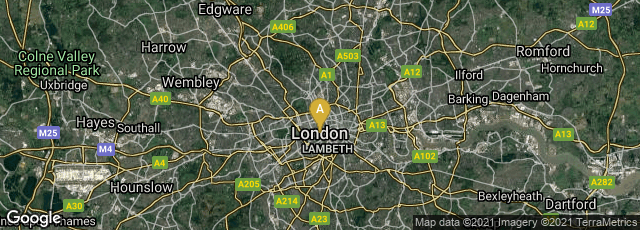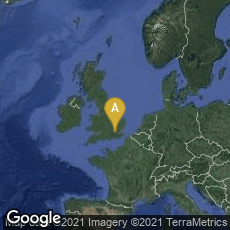

A: London, England, United Kingdom
During the 1970s I purchased from the Heritage Bookshop in Los Angeles a manuscript by the English mathematician and technician William Bourne partly written in a very distinctive Elizabethan hand, and incorporating captioned line drawings illustrating the text. The title of the manuscript was Inventions or Devices. The Weinsteins, owners of Heritage, sold the manuscript as an early copy of the book, as most of the text was written in a standard Elizabethan secretarial hand, and priced it accordingly. But the author signed the manuscript in two or three places, and the dedication was written out in the same distinctive hand as the signatures. These factors caused me to wonder if it was possibly an autograph manuscript written by and for the author himself.
There were at the time one or two reproductions of pages of Bourne's handwriting in books from examples in the British Library, and the distinctive style of writing and illustration reproduced was virtually identical to my manuscript, both in the secretarial text and Bourne's possible autograph portions. Bourne's last will and testament was also preserved in the Kent County record office, if memory serves. As wills contain a reliable example of the signer's autograph signature, I sent for a copy of that, and it corresponded exactly to the signatures in my volume. So, I was most excited to conclude that I had discovered the original manuscript— partly autograph—of a complete Elizabethan work on military inventions and naval tactics, including such inventions as fire ships used by the English against the Spanish Armada. Bourne's manuscript was written out and dedicated to William Cecil, 1st Baron Burghley, chief advisor to Elizabeth I. It was first published in print in 1578.
"Inventions or Devises, published in 1578, is one of William Bourne's more important works. This book gives many guides and instructional tools for sailors, mostly concerning interactions with other ships. The 21st device listed is the earliest known description of a ship's log and line. The 75th device on the list is a description of a night signal or early semaphore system to be used between people on distant ships who had previously decided on a code consisting of a series of lights and fashion of standing. The 110th entry is a very early description of a telescope. He describes a device consisting of two glasses that, when arranged properly, will allow you to read a letter from a quarter-mile away or see a man, town, or castle from four or five miles away. This description predates the earliest known working telescope by 30 years.
"His design, detailed in his book Inventions or Devises published in 1578, was one of the first recorded plans for an underwater navigation vehicle. He designed an enclosed craft capable of submerging by decreasing the overall volume (rather than flooding chambers as in modern submarines), and being rowed underwater. Bourne described a ship with a wooden frame covered in waterproofed leather, but the description was a general principle rather than a detailed plan. However, Bourne's concept of an underwater rowing boat was put into action by the Dutchman Cornelius Drebbel in 1620, and Nathaniel Symons demonstrated a 'sinking boat' in 1729 using the expanding and contracting volume of the boat to submerge" (Wikipedia article on William Bourne, accessed 11-18-2013).
In those days there were, of course, no digital facsimiles available online, but I was able to obtain a xerographic facsimile of the first printed edition from University Microfilms. Comparison of the text with the printed version showed various textual differences and differences between images in my manuscript with those in the printed version. In the autograph dedication Bourne referred to his previous contacts with Burghley: ‘about 3 years past I delivered your Lordship a book’, which must have been Sloane 3651 (1572/73), which was eventually divided into two works published in print in 1578 as Treasure for Travellers and the Art of Shooting in Great Ordnance.
Having worked in the antiquarian book trade for forty-nine years (as of 2013), I can report that it is not unusual for the reception of material by customers to be the converse of its historical significance. In this case the obvious institutional buyers of this invaluable manuscript passed it up through private offers and its appearance in two of our printed rare book catalogues. We catalogued the manuscript first in 1980 in our eighth catalogue entitled Twelve Manuscripts, which also contained notable items such as the autograph manuscript of J. S. Mill's Considerations on Representative Government (1860). Eventually, I consigned the Bourne manuscript to Christie's in London in their sale of November 29, 1999 where it was purchased by the American collector Lawrence Schoenberg. It is preserved in the Lawrence J. Schoenberg Collection at The University of Pennsylvania (ljs345). A digital facsimile is available from the Schoenberg Center for Electronic Text and Image at this link.
I am very gratified that Mr. Schoenberg appreciated my discovery. From the description of the manuscript at the University of Pennsylvania I quote:
Inventions or Devices was first produced two years before its first printing and contains 133 devices, twenty more than the printed edition. This manuscript contains 10 illustrations, six more than the printed work. However, the manuscript does not have 20 devices that appear in the printed book including Bourne's original design for a submarine and a diving suit. The changes in the printed version show an increased interest in the military focus of the material over surveying and measurement. The manuscript is a complete, signed, authorial, pioneering work on military gunnery, tactics and navigation. This work formed the beginning of English literature of navigation."
In December 2016 Stephen Johnston, Assistant Keeper of the Museum of the History of Science at Oxford, informed me that he incorporated details from this HistoryofInformation.com entry into his A revised bibliography of William Bourne. Johnston updated the bibliography written by D.W. Waters and R.A. Skelton published in E.G.R. Taylor's Hakluyt Society edition of A Regiment for the Sea and other Writings on Navigation by William Bourne of Gravesend, a Gunner (c. 1535-1582) (Cambridge, 1963).
(This entry was last updated in December 2016.)